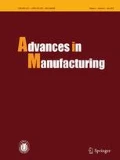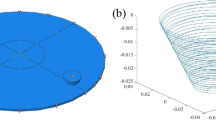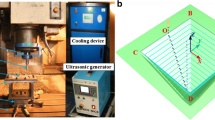Abstract
The integration of ultrasonic vibration into sheet forming process can significantly reduce the forming force and bring benefits including the enhancement of surface quality, the enhancement of formability and the reduction of spring-back. However, the influencing mechanisms of the high-frequency vibration on parts properties during the incremental sheet forming (ISF) process are not well known, preventing a more efficient forming system. This paper comprehensively investigates the effects of different process parameters (vibration amplitude, step-down size, rotation speed and forming angle) on the micro-hardness, minimum thickness, forming limit and residual stress of the formed parts. First, a series of truncated pyramids were formed with an experimental platform designed for the ultrasonic-assisted incremental sheet forming. Then, micro-hardness tests, minimum thickness measurements and residual stress tests were performed for the formed parts. The results showed that the surface micro-hardness of the formed part was reduced since the vibration stress induced by the ultrasonic vibration within the material which eliminated the original internal stress. The superimposed ultrasonic vibration can effectively uniform the residual stress and thickness distribution, and improve the forming limit in the case of the small deformation rate. In addition, through the tensile fracture analysis of the formed part, it is shown that the elongation of material is improved and the elastic modulus and hardening index are decreased. The findings of the present work lay the foundation for a better integration of the ultrasonic vibration system into the incremental sheet forming process.














Similar content being viewed by others
References
Edward L (1967) Apparatus and process for incremental dieless forming. US Patent 3342051, 19 Sept 1967
Kumar A, Gulati V, Kumar P et al (2019) Forming force in incremental sheet forming: a comparative analysis of the state of the art. J Braz Soc Mech Sci Eng 41(6):1–45
Mohanty S, Regalla SP, Daseswara Rao YV (2019) Robot-assisted incremental sheet metal forming under the different forming condition. J Braz Soc Mech Sci Eng 41(2):81
Ambrogio G, Cozza V, Filice L et al (2007) An analytical model for improving precision in single point incremental forming. J Mater Process Technol 191(1/3):92–95
Boudhaouia S, Gahbiche MA, Ayed Y et al (2017) Experimental and numerical study of a new hybrid process: multi-point incremental forming (MPIF). Int J Mater Form 11(6):815–827
Li MZ, Cai ZY, Sui Z et al (2002) Multi-point forming technology for sheet metal. J Mater Process Technol 129(1/3):333–338
Li XQ, Han K, Xu P et al (2020) Experimental and theoretical analysis of the thickness distribution in multistage two point incremental sheet forming. Int J Adv Manuf Technol 107(1/2):191–203
Mohammadi A, Vanhove H, Van Bael A et al (2014) Towards accuracy improvement in single point incremental forming of shallow parts formed under laser assisted conditions. Int J Mater Form 9(3):339–351
Duflou JR, Callebaut B, Verbert J et al (2007) Laser assisted incremental forming: Formability and accuracy improvement. Cirp Ann-Manuf Technol 56(1):273–276
An ZG, Yan D, Qie JJ (2020) Effect of process parameters on formability of a AZ31 magnesium alloy thin-walled cylindrical part formed by multistage warm single-point incremental forming. Front Mater 7:151. https://doi.org/10.3389/fmats.2020.00151
Min JY, Seim P, Storkle D et al (2017) Thermal modeling in electricity assisted incremental sheet forming. Int J Mater Form 10(5):729–739
Vahdani M, Mirnia MJ, Bakhshi-Jooybari M et al (2019) Electric hot incremental sheet forming of Ti-6Al-4V titanium, AA6061 aluminum, and DC01 steel sheets. Int J Adv Manuf Technol 103(1/4):1199–1209
Li YL, Zhai WD, Wang ZJ et al (2020) Investigation on the material flow and deformation behavior during ultrasonic-assisted incremental forming of straight grooves. J Mater Res Technol 9(1):433–454
Zhai WD, Li YL, Cheng ZN et al (2020) Investigation on the forming force and surface quality during ultrasonic-assisted incremental sheet forming process. Int J Adv Manuf Technol 106(7/8):2703–2719
Emmens WC, van den Boogaard AH (2008) Tensile tests with bending: a mechanism for incremental forming. Int J Mater Form 1:1155–1158
Fan GP, Gao L (2014) Mechanical property of Ti-6Al-4V sheet in one-sided electric hot incremental forming. Int J Adv Manuf Technol 72(5/8):989–994
Li YL, Chen XX, Zhai WD et al (2018) Effects of process parameters on thickness thinning and mechanical properties of the formed parts in incremental sheet forming. Int J Adv Manuf Technol 98(9/12):3071–3080
Hussain G, Gao L (2007) A novel method to test the thinning limits of sheet metals in negative incremental forming. Int J Mach Tools Manuf 47(3/4):419–435
Filice L, Ambrogio G, Gaudioso M (2013) Optimised tool-path design to reduce thinning in incremental sheet forming process. Int J Mater Form 6(1):173–178
Kim TJ, Yang DY (2000) Improvement of formability for the incremental sheet metal forming process. Int J Mech Sci 42(7):1271–1286
Bambach M, Taleb AB, Hirt G (2009) Strategies to improve the geometric accuracy in asymmetric single point incremental forming. Prod Eng 3(2):145–156
Radu C, Tampu C, Cristea I et al (2013) The effect of residual stresses on the accuracy of parts processed by SPIF. Mater Manuf Process 28(5):572–576
Radu C, Herghelegiu E, Tampu C et al (2013) The residual stress state generated by single point incremental forming of aluminum metal sheets. Appl Mech Mater 371:148–152
Singh A, Agrawal A (2015) Investigation of surface residual stress distribution in deformation machining process for aluminum alloy. J Mater Process Technol 225:195–202
Jimenez I, Lopez C, Martinez-Romero O et al (2017) Investigation of residual stress distribution in single point incremental forming of aluminum parts by X-ray diffraction technique. Int J Adv Manuf Technol 91(5/8):2571–2580
Subrahmanyam A, Lingam R, Hayakawa K et al (2020) Experimental and numerical investigation of residual stresses in incremental forming. Mater Trans 61(2):228–233
Khazaali H, Fereshteh-Saniee F (2016) A comprehensive experimental investigation on the influences of the process variables on warm incremental forming of Ti-6Al-4V titanium alloy using a simple technique. Int J Adv Manuf Technol 87(9/12):2911–2923
Shaolin XU, Kuriyagawa T, Shimada K (2017) Recent advances in ultrasonic-assisted machining for the fabrication of micro/nano-textured surfaces. Front Mech Eng 12(1):33–45
Wang P, Wang D (2020) Evaluation of different tool geometries in the finite element simulation of ultrasonic-assisted drilling of Ti6A14V. J Braz Soc Mech Sci Eng 42(4):205–210
Vahdati M, Mahdavinejad R, Amini S (2017) Investigation of the ultrasonic vibration effect in incremental sheet metal forming process. P I Mech Eng B J Eng 231(6):971–982
Amini S, Gollo AH, Paktinat H (2017) An investigation of conventional and ultrasonic-assisted incremental forming of annealed AA1050 sheet. Int J Adv Manuf Technol 90(5/8):1569–1578
Dawson GR, Winsper CE, Sansome DH (1970) Application of high and low-frequency oscillations to the plastic deformation of metal. Metal Form 8:234–238
Centeno G, Bagudanch I, Martinez-Donaire AJ et al (2014) Critical analysis of necking and fracture limit strains and forming forces in single-point incremental forming. Mater Des 63:20–29
Saito Y, Utsunomiya H, Tsuji N et al (1999) Novel ultra-high straining process for bulk materials development of the accumulative roll-bonding (ARB) process. Acta Mater 47(2):579–583
Long YY, Li YL, Sun J et al (2018) Effects of process parameters on force reduction and temperature variation during ultrasonic assisted incremental sheet forming process. Int J Adv Manuf Technol 97(1/4):13–24
Petch NJ (1953) The cleavage strength of polycrystals. J Iron Steel I 174(1):25–28
Deshpande A, Hsu K (2018) Acoustic energy enabled dynamic recovery in aluminium and its effects on stress evolution and post-deformation microstructure. Mat Sci Eng A Struct 711:62–68
Jing L, Lui G (2006) Study on surface integrity in hard milling of hardened die steel. Mat Sci Forum. 532/533:540–543
Acknowledgement
This work is supported by the National Natural Science Foundation of China (Grant Nos. 51975328, 51605258), the Postdoctoral Innovation Project of Shandong Province (Grant No. 201701011) and Young Scholars Program of Shandong University (Grant No. 2018WLJH55).
Author information
Authors and Affiliations
Corresponding author
Rights and permissions
About this article
Cite this article
Li, YL., Wang, ZJ., Zhai, WD. et al. The influence of ultrasonic vibration on parts properties during incremental sheet forming. Adv. Manuf. 9, 250–261 (2021). https://doi.org/10.1007/s40436-021-00347-0
Received:
Revised:
Accepted:
Published:
Issue Date:
DOI: https://doi.org/10.1007/s40436-021-00347-0




